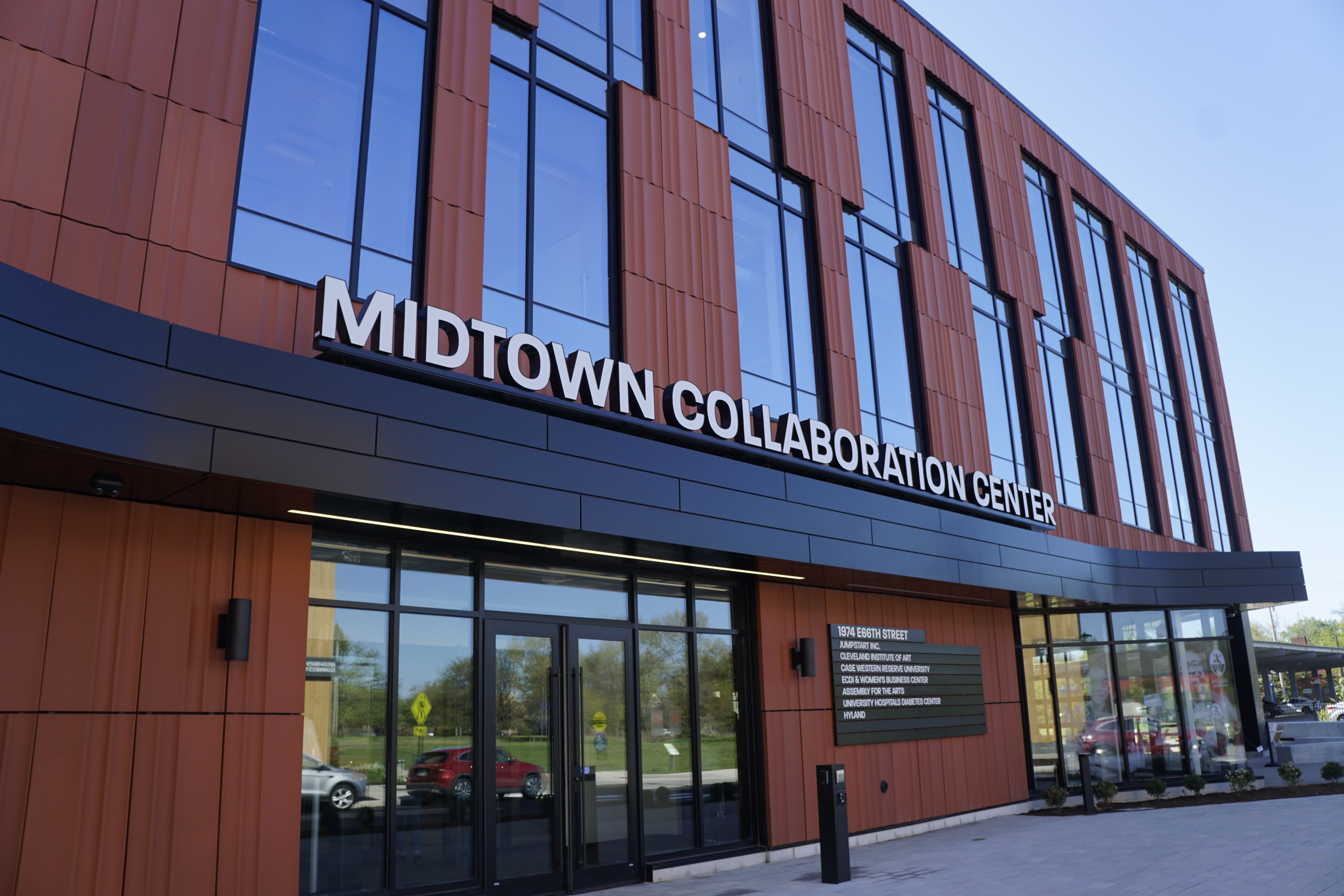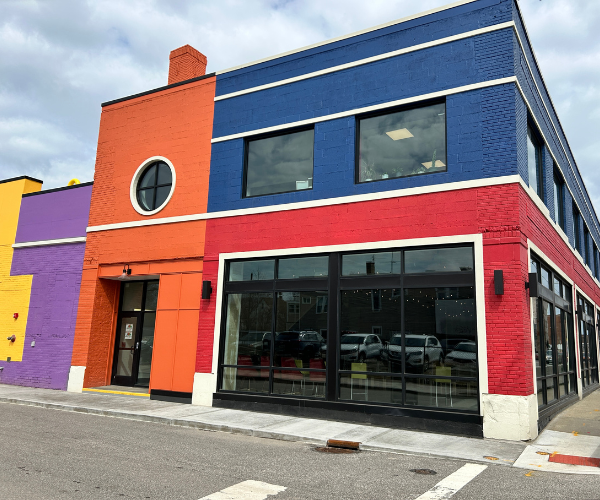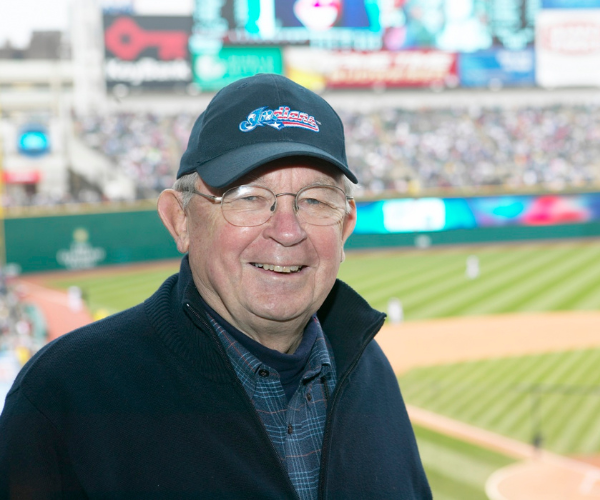Remember Tent City
by James Bigley II | Mar. 12, 2019 | 4:00 PM

PHOTOGRAPHED BY KEVIN KOPANSKI
This is Tent City. Or what’s left of it.
Where there were once 50 multicolored tents, now there’s only 10, many of them torn, partially collapsed. A mound of garbage bags by the backdoor of the brick building at 15 Broad St. waits to be transported to the dumpster out front. Pallets, once used as a foundation to keep tents off the wet ground, are now broken and rotted through, stacked in a heap waiting to be used for firewood.
The looming husk of an $11 million mixed-use senior living development casts a shadow from across the street, a sign of a brighter future. But tagged on the retaining wall separating the Akron homeless village from an older low-income senior housing apartment complex next door, there’s a haunting message written with spray paint: Remember Tent City.
It’s Jan. 3 and Sage Lewis, executive director of the Homeless Charity and Village, is currently dismantling the makeshift homes that were built on his property at 15 Broad St. over the last two years.
Around 9:30 a.m., he finds Sully*, one of the 50 homeless individuals who lived at Tent City, sitting in the middle of his basement.
“How are your tents?” Lewis asks. “Can we package them up?”
Sully has a large canopy out back, big enough to fit another two-person tent inside of it. Together, they provide a protective barrier against the cold.
“I’m just going to drop them to the ground,” he says, with a thick drawl that makes him difficult to understand.
A registered sex offender, the 54-year-old has been living in his tents on Lewis’ land since May. Even though he just got an apartment in December, he wants to keep his tents here. He’s moved them just across the property line to the vacant lot next-door.
“I set that up as a community tent for everybody that was going to be over there,” says Sully.
Still, Lewis needs it to be well away from his property or he’ll face consequences from the city.
The tents have to go.
“When it dies down we can talk again,” says Lewis. “But we need shit clear, man. We need less tents.”
Outfitted in a black cowboy hat, camouflage jacket and snow boots, Lewis works his way through the underbelly of his brick building, past a collection of 30 bicycles in need of repair and storage rooms stocked full of pillows, blankets and various items. In the community room at the end of the hall, he comes across 10 men and women sleeping — some huddled together on small couches and others under blankets on the floor to keep warm.
Lewis claps loudly to stir them awake. He needs them to get moving — they can’t stay here anymore.
Turning people away is against the norm for Lewis, who’s become an advocate for Akron’s homeless community. Since January 2017, he’s allowed many of them to use his building as a day center where they eat, shower, do laundry, learn trade skills and warm up during the winter. He even started his nonprofit and allowed some to establish the camp behind his building — with its own governing set of rules and regulations.
But today is the end of Tent City.
In September 2018, the city of Akron denied Lewis a request to change the zoning of his private land, which would have allowed him to operate a campground legally.
When the city ordered the removal of the tents, it agreed to expedite resources and house the 46 residents who were living there at the time. Today, five of those initial residents remain unhoused along with an additional 22 who showed up at the village seeking shelter since the beginning of that process. They have 48 hours left.
So over the next three hours, Lewis works to clean up the mess with volunteers from the community. As they transport trash to the dumpster out front, he makes intermittent trips between remaining tents like a sheriff checking in on a band of transient misfits.
Steve, the 28-year-old who heads camp security, is sick and won’t come out of his tent.
Sully stands outside of his encampment scratching his head — he’s got 14 pallets making up the foundation for his tents and a side deck built for when he can lounge outside in the summer. He’s trying to figure out how to move everything without dismantling it completely.
Donna Jean, a 52-year-old mother of two, hasn’t yet cleared out her possessions. Inside her tent, she’s got a mound of clothes, blankets, stuffed animals and suitcases beside a quilt-covered cot. She keeps a small collection of glass cat figurines on the top shelf of a kitchen rack in the corner. The second shelf holds bottles of water, a pound of sugar and a bruised banana. Everything she owns is in this tent.
Lewis is fighting to keep them safe by appealing the city’s decision. He wants to keep their tiny community thriving, but for now he’s got to focus on the task at hand. The exodus has begun and there’s nothing he can do to stop it.
“What is ironic and tragic is we were doing a thing,” shouts Lewis. “We had a thing and they were like, ‘No, f--k you!’”

The vision of Tent City has always been designed for and by the homeless. With an estimated 3,000 homeless individuals in Akron seeking shelter and services each year, it provides an alternative to the city’s traditional shelter system.
Lewis argues that he’s filling a gap for those resistant to shelter.
“We’re trying to meet the homeless where they are today,” he says. “Most people want the homeless in a little cube, away and invisible.”
At its peak, Tent City had become a self-sustained safe haven for homeless residents. They elected members from within their own tented community to sit on a village council and oversee day-to-day operations, creating a governing set of rules everyone agreed upon.
When it was running properly, alcohol and drugs were not allowed on the premises. Residents with active addictions were asked to take them off of the property and not return for 24 hours or until they were sober. Any resident was subject to a search at any given time to ensure the safety of the village, and any violation of these rules resulted in a 24-hour ban, required treatment or eviction.
At its busiest, there was enough room for 50 tenants. Newcomers wanting to be a part of the camp had to be vetted and put on a waiting list. Once approved for entry, a new resident was given a 10-by-10-foot lot with a tent, tarp and a pallet on which to set up their new temporary home. It was up to them to build their site.
“You need to save yourself,” says Lewis. “You’re getting your own blankets. You’re deciding how you’re going to stay warm. You’re getting your own clothes. You’re finding your own food.”
In exchange for a plot of land, each resident was required to put in an hour of work each day toward the upkeep of the facility. Sometimes this involved collecting food for the pantry, cooking meals, working in a small garden, cleaning toilets, making necessary repairs to the main building and maintaining campsites.
Residents were encouraged to find outside employment. Many others were empowered to take on volunteer staff positions in the day center to oversee the laundry room, implement 24-hour security, and create an administrative team to connect residents to resources and city services such as transportation, medical care and housing.
From the minute residents became a part of this community, it was entirely up to them to band together, keep the community safe and keep it running. Lewis simply carved up his private land so they could take ownership over their lives. He started the Homeless Charity to help them long term.
“Most of these people have never been given that kind of authority in their lives,” says Lewis. “As I watched these people create something that was really very beautiful, I could see them gaining their human dignity back.”
Those who came in the dead of night seeking emergency shelter were dubbed “overnight warriors” and allowed to stay in the community room until they could go through intake with staff in the morning. The waitlist to be a part of the community ebbed and flowed with the changing of the seasons, sometimes growing to more than 20 individuals interested in being a part of the village during the winter.
For people like Herman, a 67-year-old retired foreman who had been found living under a bush in the woods, Tent City offered a kind of salvation. He had left an abusive relationship and had nowhere to go. So they took him in during the summer of 2017. After five months, he was able to save up enough of his Social Security to get into a one-bedroom apartment a few blocks from the center. Now, as a member of the village council and the manager of the thrift store, he keeps coming back to help others.
“You go from this minute being nothing and worthless, to this minute mattering,” says Lewis. “Then, you watch another homeless person coming in through those doors and you help them. You now, in many ways, become this enlightened and important person in society. You’re helping people survive.”

Lewis needed a change.
In 1999, he started SageRock Inc., an online marketing and digital advertising agency, alongside his wife Rocky. At its peak, Lewis says the company grew to 25 employees, making more than $1.5 million annually by serving companies such as Medical Mutual and the Cleveland Cavaliers. But after the 2008 recession, the company was forced to drop down to just three employees.
“The recession really gutted my business and really made me bitter to the callousness of capitalism,” says Lewis. “I was looking for something else.”
When longstanding Akron Mayor Don Plusquellic announced in 2015 he was resigning after 28 years in office, Lewis threw his cowboy hat into the ring.
The Medina native had no previous political aspirations, but he was a businessman just trying to stay afloat — and he thought that would resonate with the public.
“I am no saint. I am no idealist. I am no altruistic soul on planet Earth,” says Lewis. “I’m just a guy that got beat up in a recession and wanted to do something else with his life, something meaningful.”
So he took to the streets with no real campaign, billing himself as a relatable everyman and not just your run-of-the-mill politician. When he marched downtown to get enough signatures so he could get on the ballot for the primary, the only ones who paid him any attention were the homeless.
“I had all the stereotypical classist beliefs of homeless people going into this — lazy, drug-dealing, no-good people who should get a job,” says Lewis. “But getting to know people is a hell of a thing.”
He learned why many of them were resistant to seeking shelter at Haven of Rest, Akron’s largest emergency shelter with the capacity for 200. The facility was often overcrowded. Couples were split up and separated into separate divisions. Registered sex offenders were denied access to overnight shelter because children were kept in the women’s division. As a faith-based organization, residents received lunch and dinner only after attending chapel services. For some members of the already transient population, this made it even more difficult to stray far from the facility during the day.
“People don’t understand,” says Paul, a 53-year-old who met Lewis during his campaign and who had been homeless for more than seven years. “They think homeless people want to be dependent on society but we don’t. We don’t want to bother anybody. We’re trying to get out of their way.”
Lewis failed to ever get on the ballot because the signatures he acquired could not be verified by the board of elections. The homeless individuals who signed his petition were either not registered to vote or had no valid address. Still, Lewis says it was a transformative experience.
“Getting the opportunity to spend time thinking about government and what you would actually do in government and imagining yourself in government is an amazing experience, because you start thinking about these real issues,” says Lewis.
Despite his personal setback, he found a way forward by turning to the community that had accepted him — the homeless.
“They know all about their city,” he says. “They’re highly knowledgeable, highly aware of their surroundings, and aware of their position in life and how they are perceived.”
So he hired a few individuals, including Paul, to help him run his business, Rubber City Auctions, out of his brick building at 15 Broad St. Before each monthly show, they’d set up furniture and antiques in the basement. Anything leftover was kept until the next showing. When one of Paul’s homeless friends asked if he could help sell some of the smaller leftover items to raise money for food and supplies, Lewis signed on to the idea and allowed them to open a small thrift store in his basement free of charge.
That philanthropic decision to help someone else start a business might have been sufficient to most. But when Paul came to him at the end of December 2016 with a problem, Lewis was afforded an opportunity to make a lasting impact.
Paul, along with dozens of others, had set up camp in the woods just a mile north of Lewis’ building, hidden off the beaten path near a set of railroad tracks. They’d been found by Summit Metro Parks rangers and had been given a two-week eviction notice. The park was preparing to start construction on the Freedom Trail, a 2-mile extension of a 6-mile paved bike path that would cut right through their campsite. They needed to take all of their belongings and get out. With nowhere to go in the middle of winter, they asked Lewis if they could pitch their tents in his backyard.
“I like to tell people that the biggest thing I did was not say ‘no,’ ” says Lewis. “I make no claim to any kind of great vision, or any vision, of creating a village.”
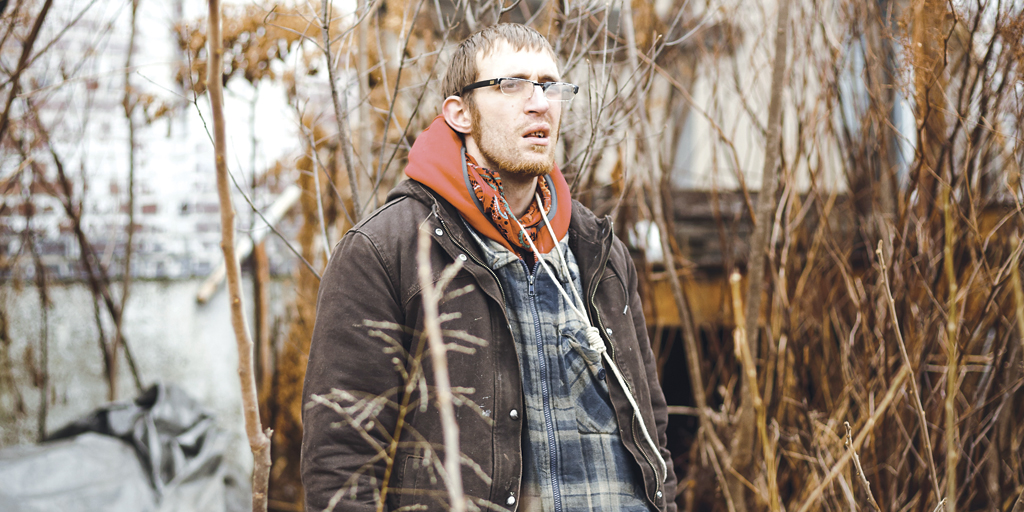
The goal is to give them a home.
Akron’s homeless prevention system, known as the Akron/Barberton/Summit County Continuum of Care, has more than 20 organizations fighting to end homelessness by focusing on a housing-first initiative. The idea revolves around finding permanent housing situations for an individual first, then providing them with rental assistance, ongoing counseling, mental health services and job training so they can begin to address other concerns in their lives once they’ve been housed.
To receive housing, most individuals enter the city’s shelter system.
“The goal is to give people a jumpstart back on their feet,” says Keith Stahl, director of residential services and operations for mental health service provider Community Support Services. “Some people will need lots of help and others are going to just need a little.”
Paul, a founder of Tent City, is one of many who has largely rejected the idea of utilizing traditional shelters. When he’s turned to Haven of Rest, he says he’s been concerned for his safety.
“They were constantly throwing people out and there were just all kinds of problems,” says Paul.
According to police reports, officers responded to Haven of Rest for 234 incidents in 2017 and 2018. Fifteen of those incidents were drug-related, with eight resulting in overdoses. There were also 23 physical altercations.
“We obviously want to dismantle those as quick as possible and that’s part of why the police are called,” says Rev. Jeffrey Kaiser, executive director of Haven of Rest. “Obviously we don’t want those types of scenarios to happen, but those types of scenarios could happen anywhere.”
Tent City was certainly not immune to these problems — they’ve had a total of 230 police reports in 2017 and 2018 — only four less than Haven of Rest — with at least 10 drug-related incidents, seven of which resulted in overdoses, and 29 physical altercations.
Yet despite these incidents, Tent City prevailed in the eyes of its residents as a place of solitude and freedom. The residents didn’t view themselves as a problem that needed solving by an outside entity. Instead, their thriving community gave them an identity.
Stahl says that’s not good long term.
“We did find that people were less likely to leave homelessness because they did find some identity [at Tent City],” says Stahl. “You don’t want to make it so comfortable to be homeless that there’s no reason to change your position.”
If you have good food, if your basic needs are met and if you don’t have to pay rent, Stahl says you’re less likely to get out of that situation, and it actually prolongs one’s state of homelessness.
“By creating a policy that says it’s OK for a tent community to exist on this parcel, what we’re really doing is we’re saying that because these people are poor, because they have no other options, it’s OK that they live in substandard conditions,” says Stahl. “Instead of putting our energies into developing tent communities, we should be demanding our community leaders to build more housing, to create more affordable housing, to create more livable communities and address the issues that exist for all individuals.”
So in exchange for shutting down Tent City, the city of Akron agreed to expedite the process to house the 46 residents living in the village in early September 2018. Lewis was then asked not to take in any more residents because it would exacerbate the problem the city was working to solve.
But Lewis refused to turn anyone away. Instead, he hired lawyers from the Institute for Justice, a Virginia-based public interest law firm, to appeal city council’s decision to deny tents on his property. He also went public with the story by speaking about it frequently at city council meetings, posting about it on his blog and asking for donations through GoFundMe and other crowdsourcing applications to help the residents who were going to be displaced by this decision.
When The New York Times picked up Lewis’ story, Mayor Dan Horrigan published an op-ed in the Akron Beacon Journal, standing by city council’s decision and stating that Lewis’ tents were not a viable solution.
“We should never be comfortable with our neighbors living in conditions we would never accept for ourselves,” wrote Horrigan. “For all the posturing, loud impassioned speeches, blog posts, public requests for donations and edgy movie posters depicting him as some type of savior, Sage Lewis has made little progress on actually moving the needle on homelessness.”
Horrigan declined requests by Cleveland Magazine to be interviewed for this story.
Of the former 46 Tent City residents who were initially identified, 34 were housed.
Two were kicked out of the village during the process for violating the rules.
Three went to jail for drug-related infractions resulting in legal charges.
Seven cases were considered unresolved because the Tent City occupant was not present at the time assistance was offered.
“These are not fugitives. These are not illegal aliens,” says Lewis. “These are people whose families have been here for generations and now because these people are down on their luck and they make no money and they don’t vote, they are the enemy.”

Roger hobbles alongside the railroad tracks beside an enormous abandoned factory, lugging a bright red dolly behind him with his personal belongings — coats, blankets, tattered hoodies — duct-taped inside black, industrial-sized trash bags. In his other hand, he carries a small metal trash bin with a hole cut out of the side so he can load it from the bottom with twigs and small pieces of wood to start a fire.
At 27, he’s pale but sturdy with thinning brown hair and an unshaven face. His glasses sit awkwardly on his nose, the left lens broken, and he’s got a red bandana tied loosely around his neck. Twenty feet in front of him, Lewis trudges along with another full garbage bag in his right hand. Weighed down by an enormous gray tarp slung over his left shoulder, Lewis bends forward and begins to slow down.
This is the third camp Lewis has set up in the wilderness after the dismantling of Tent City. The other two camps — both within a couple miles of his building — have been shut down by the Akron Police Dept. But Lewis carries on with the mission. If his people have nowhere to go, then he can at least try to keep them safe until better solutions present themselves. Sometimes, that’s all someone can do.
Roger showed up at Lewis’ village in October in the middle of the night wearing nothing but a shirt and shorts. He says he was kicked out of a group home after getting into a fight. He didn’t want to go into the shelter system and his older brother, Steve, had been head of security at Tent City. So Roger went to Tent City instead — right as the city was working to house its residents. Since the process had already begun, he’d arrived too late to be included in the initial 46 the city promised to house.
“I’ve been homeless off-and-on since I was 14,” he says.
Arguments with his parents resulted in getting kicked out into the street. He says he’s been diagnosed with schizophrenia and suffers from frequent anxiety attacks. Last year he lost most of his belongings in a house fire. Since then, he’s been evicted from other homes for sheltering other friends and exceeding the allowable occupancy limit.
“The longest I stayed in a spot was three months,” says Roger. “I worry about everybody more than I worry about myself. My mom says I need to start being selfish, but I don’t really have much needs. I’m content with the bare minimum.”
After a few minutes, Roger and Lewis pull off the gravel path by the tracks and head into the brush where a camp has been set up underneath one of the factory’s loading docks. Roger has hung up tarps on three sides of the dock to keep the elements at bay. Inside, there are numerous bags of his possessions, cushions and an old metal cot. Somewhere, he’s got a photo tucked away from when he went to church camp as a child.
“I wanted to be a pastor for a while,” he says. “I like helping people.”
This will be his home for the foreseeable future, hidden from plain sight, burrowed into the back of an abandoned building. If he survives the winter, the brush will create a natural enclosure of green to keep him safe. Luckily, he’s not alone. He’s got three other people from Tent City staying with him from the village. Another two have moved a mile down the tracks to set up their own camps. All five are hoping to band together and share resources.
“It’s hard living outside,” he says. “But it’s even harder living outside by yourself.”
As we leave Roger at his camp and make our way back to the truck parked on the street in the distance, Lewis gives a halfhearted chuckle.
“I’m happy for him,” he says. “That’s gold. That’s top-of-the-line right there.”
Before getting into the vehicle, Lewis stops and turns around to make sure Roger is out of sight. He checks left, then right, making sure there aren’t any cars on the road. He doesn’t want to draw unnecessary attention to Roger’s camp, lest Roger be forced to find shelter elsewhere like the others he’s helped.
As we leave, I’m bewildered. This doesn’t seem right, leaving someone out in the wilderness like that. I ask Lewis if he’s ever overwhelmed by the temporary nature of it all, or if he sees himself up against a lost cause.
“The world is a lost cause,” says Lewis, gripping the steering wheel and settling into his seat. “You’ll never win in life. But that doesn’t mean you quit. You make a little push forward, you know?”

Lewis’ work is far from over. He has plans to keep his day center at 15 Broad St. up and running 24 hours a day with an added entrepreneurial arm. Already, former residents are creating T-shirts with a screen-printing press, running a bike repair and loan program for anyone without transportation, operating a woodworking shop and offering computer repairs and website development for those trying to start a business.
By March 1, they hope to open a convenient store on the first floor where they’ll sell affordable survival gear to the homeless alongside shirts created in the basement to raise awareness of their mission.
“A huge part of getting these folks to a good space in life is to help them reestablish their value in society,” says Lewis’ wife, Rocky. “It was a founding principle of this charity that this is their creation.”
But Lewis isn’t stopping there — he’s buying into the city’s mission to emphasize housing first by purchasing homes within a couple miles of the center to keep his community close. He’s got two houses under his belt already, purchased from a private owner and the Summit County Land Bank — and they’re run like his tent-based operation.
Lewis purchased the first house last year at the back of his lot. The two-story, 1,056-square-foot, 3-bedroom, 1-bathroom home holds six people and operates as a Christian-based sober house. There’s no drugs or alcohol on the property, and tenants can live there rent-free so long as they put in about 20 hours of work per month in exchange for room and board.
The house manager, Gary Mikes, has created his own nonprofit, Houses for Homeless, geared toward purchasing and rehabbing buildings for low-income residents. He hosts mandatory meetings for the residents of this home every Friday night to address problems as they arise. There’s even talks of getting a skid of food from the Akron-Canton Regional Foodbank and including that as part of a tenant’s occupancy. A chore list sits in a small curio cabinet in the living room, although they’re having a hard time getting residents to pull their weight.
“I feel that’s just a learning curve,” says Lewis. “I’ll figure it out. I learned a lot on how to handle tents. I just need to learn how to handle transitional housing.”
The second house, less than a mile away on North Arlington Street, runs in a very different way. Some of the five residents have active addictions. The house leader, Chris, acted as a counselor at Tent City, connecting residents to mental health services and substance abuse treatments. He reviewed their cases, talked with them about their addictions, and motivated them to get help.
“This place allows me to be more observant of what is going on in our lives,” says Chris, eyes downcast, cigarette hanging limp in his left hand. “It’s tough to almost admit to yourself that something in your head ain’t right. They feel like they failed. I know I did and I still do sometimes.”
The two-bedroom and two-bath home was condemned just two weeks after Lewis purchased it in January for $4,764.28 from the Summit County Land Bank. Repairs are needed — lighting fixtures, exposed outlets, windows, fractured doorways, roof and flooring — to meet the land bank’s minimum renovation requirements. If they don’t complete these renovations, they run the risk of taking on the entire mortgage of $21,525. Until it’s cleared by a city inspector, residents cannot sleep in the home overnight. But work is already underway to make those repairs, and Lewis has raised almost $2,000 of donations to go toward that effort.
Going forward, Lewis hopes to purchase at least one more house this year using personal funds and money donated to his charity. It will allow him to implement house rules and a permanent housing plan for nearly 15 residents across the community.
“I’m buying houses, I’m sheltering people in the woods, but I am now an activist,” says Lewis. “I am changing things.”

A week after Tent City comes down, I join Lewis on an excursion to an encampment hidden underneath the overpass near Haven of Rest. Parking at the top of a hill, we walk down to find a smattering of tents propped up within 15 feet of the railroad beside a wooden structure draped with sheets of plastic to keep out the wind and the cold. Inside the makeshift shack, four men huddle around a burning barrel to keep warm.
As Lewis approaches the site, they come out to greet him. Their leader, Matt, shakes Lewis’ hand. Lewis has come bearing gifts for the people who live here: pallets leftover from his fallen village. Matt is grateful — cold times are ahead.
“Everybody knows you can come down here and get warm, but we only have a certain supply of wood,” he says. “When it gets to a certain point at night, we shut it down and the people who live here go into our tents.”
Matt says he’s been living here since May. Although he was never a resident of Lewis’ village, he’s traveled there to take showers and use their computers. Despite not being a part of Tent City, he’s implemented similar rules: no drugs, no severe intoxication, and if someone shows up needing assistance, the group provides it.
“Sometimes we’ll have people stay in that tepee,” he says, pointing to a faded green tent. “We have other areas, two bridges.”
Matt says he had a home over the summer but left it behind when his relationship with his significant other ended. He’s no stranger to living off the land — he was voluntarily homeless for two years outside Flagstaff, Arizona, and recently migrated east.
As a mason, he works during the warmer months, but it’s hard to find work during the winter. In November, he picked up a job from a guy in Cleveland who offered to put him up in a hotel for the night.
“I couldn’t even sleep in the bed,” he says. “I’m so used to being out here now.”
We follow him a couple hundred feet to the other side of the tracks, where a few small tents have collapsed underneath the other side of the bridge. This camp, Matt tells us, is different than the one he oversees. These guys have drug addictions and don’t take care of their property. The two camps operate independently of one another but Matt still tries to do what he can to help.
“This guy gave me two beers and a pack of cigarettes to stay in this tent for one night and then left,” says Matt, bending down to fold up the white tent left behind, the tags still on the zipper.
Lewis asks if there’s anything they need, and Matt’s friend, an African-American man who goes by the name of True Blue, says they could use some pots and pans to cook food over the fire. Matt asks for some extra tarps and materials to mend his tents. The zipper on his tent is broken, and if anyone else needs repairs, he wants to be able to help.
“There’s a reason why I’m down here,” says Matt. “For some reason, whatever happened to me, I’m here to help people.”
Lewis recognizes the need. Matt and Lewis are both fighting for the same mission. As Matt gears up to help himself and others like him, Lewis is trying to be the stop-gap that catches and empowers those who are shelter resistant — the ones who’ve lost their way, the strong-willed grandparents who’ve lost their spouses, the weary brother who dreamed of being a preacher, the ones left behind who are fighting to get far enough ahead.
Even when his zoning appeal is denied Jan. 30, he moves forward with his plans to appeal the decision. But for now, he’s here doing the work.
“I’m going to try to empower you so you can do this outreach here,” says Lewis, adjusting the black cowboy hat on his head. “You’re doing great.”
“I’m trying to do as much as I can,” says Matt. “I can survive out here and I’m going to work.”
“Believe it or not, man, we need you,” says Lewis, turning to face the other side of the tracks from where we came. “When you can’t handle it anymore, you can go indoors. But if you’re feeling the call, then do the work.”
Suddenly, a train rounds the bend, tearing through the two encampments, separating us from the tents on Matt’s side. The ground shakes violently beneath our feet, and the train brings with it a ripping, roaring wind so loud and long, I’ve forgotten this is only temporary by the time we’re left behind.
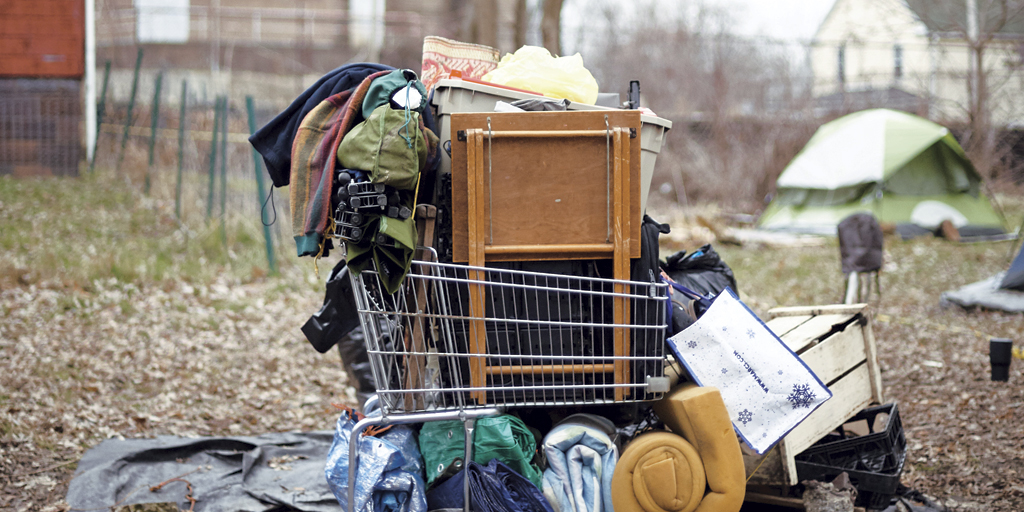
For more updates about Cleveland, sign up for our Cleveland Magazine Daily newsletter, delivered to your inbox six times a week.
Cleveland Magazine is also available in print, publishing 12 times a year with immersive features, helpful guides and beautiful photography and design.
Trending
-
1
-
2
-
3
-
4
-
5



